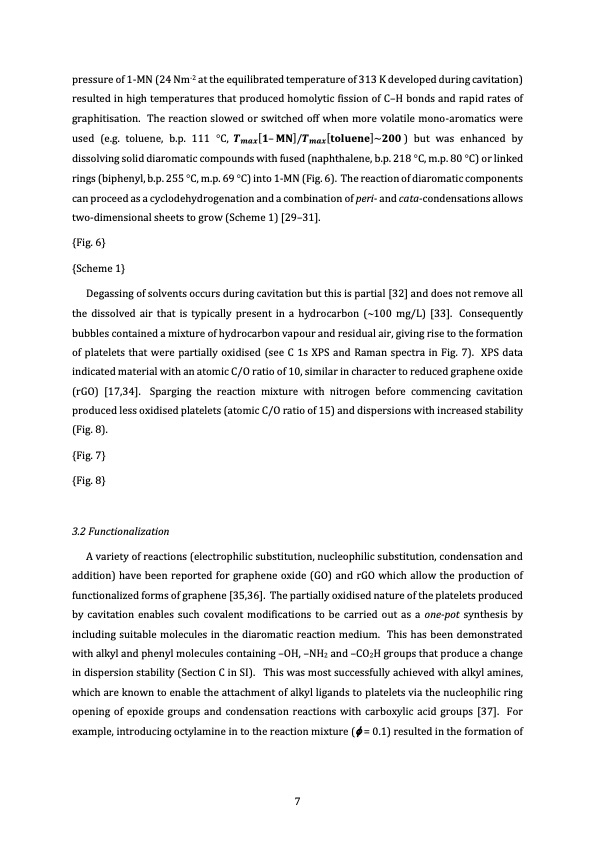PDF Publication Title:
Text from PDF Page: 008
pressure of 1-MN (24 Nm-2 at the equilibrated temperature of 313 K developed during cavitation) resulted in high temperatures that produced homolytic fission of C–H bonds and rapid rates of graphitisation. The reaction slowed or switched off when more volatile mono-aromatics were used (e.g. toluene, b.p. 111 C, 𝑻𝒎𝒂𝒙[𝟏–𝐌𝐍]/𝑻𝒎𝒂𝒙[𝐭𝐨𝐥𝐮𝐞𝐧𝐞]~𝟐𝟎𝟎) but was enhanced by dissolving solid diaromatic compounds with fused (naphthalene, b.p. 218 C, m.p. 80 C) or linked rings (biphenyl, b.p. 255 C, m.p. 69 C) into 1-MN (Fig. 6). The reaction of diaromatic components can proceed as a cyclodehydrogenation and a combination of peri- and cata-condensations allows two-dimensional sheets to grow (Scheme 1) [29–31]. {Fig. 6} {Scheme 1} Degassing of solvents occurs during cavitation but this is partial [32] and does not remove all the dissolved air that is typically present in a hydrocarbon (100 mg/L) [33]. Consequently bubbles contained a mixture of hydrocarbon vapour and residual air, giving rise to the formation of platelets that were partially oxidised (see C 1s XPS and Raman spectra in Fig. 7). XPS data indicated material with an atomic C/O ratio of 10, similar in character to reduced graphene oxide (rGO) [17,34]. Sparging the reaction mixture with nitrogen before commencing cavitation produced less oxidised platelets (atomic C/O ratio of 15) and dispersions with increased stability (Fig. 8). {Fig. 7} {Fig. 8} 3.2 Functionalization A variety of reactions (electrophilic substitution, nucleophilic substitution, condensation and addition) have been reported for graphene oxide (GO) and rGO which allow the production of functionalized forms of graphene [35,36]. The partially oxidised nature of the platelets produced by cavitation enables such covalent modifications to be carried out as a one-pot synthesis by including suitable molecules in the diaromatic reaction medium. This has been demonstrated with alkyl and phenyl molecules containing –OH, –NH2 and –CO2H groups that produce a change in dispersion stability (Section C in SI). This was most successfully achieved with alkyl amines, which are known to enable the attachment of alkyl ligands to platelets via the nucleophilic ring opening of epoxide groups and condensation reactions with carboxylic acid groups [37]. For example, introducing octylamine in to the reaction mixture ( = 0.1) resulted in the formation of 7PDF Image | graphene platelets with partial oxidation via cavitation

PDF Search Title:
graphene platelets with partial oxidation via cavitationOriginal File Name Searched:
Sonochemistry-Chester-Rep.pdfDIY PDF Search: Google It | Yahoo | Bing
Salgenx Redox Flow Battery Technology: Power up your energy storage game with Salgenx Salt Water Battery. With its advanced technology, the flow battery provides reliable, scalable, and sustainable energy storage for utility-scale projects. Upgrade to a Salgenx flow battery today and take control of your energy future.
CONTACT TEL: 608-238-6001 Email: greg@infinityturbine.com (Standard Web Page)